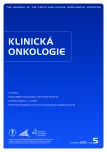The Substance of Genetic Information – Nucleic Acids
Authors:
R. Brdička
Published in:
Klin Onkol 2012; 25(5): 329-332
Category:
Reviews
Overview
If we look at the history of our knowledge of nucleic acids, we would see in the distant past of 140 years Friedrich Miescher who had identified the acidic substance within the cell nucleus, which he called nuclein. About 70 years after his initial observation, this substance was connected with genetic information. This very substantial finding happened during the World War II. This was the impulse that research of nucleic acids received to speed up continuously growing mountain of information, which is more and more difficult to understand. Another eruption of new information about our genome was the result of ten years of intensive cooperation of many manufacturers divided into two competitive blocks which offered us knowledge of nucleotide sequence of all 46 DNA molecules. The year 2000 became the landmark marking the start of the postgenomic era. It did not mean that human genome was totally explored, but the cornerstone has been settled. Since then, we could concentrate our efforts on variability; use of the project of 1,000 genomes brought many important findings, eg. copy number variability (CNV) exceeds the single nucleotide polymophisms (SNP). Also intergenomic relationships, studies on function and pathways began to be much more understandable by elucidation of the genome primary structure. NGS as a tool also accelerated the epigenetic research. All this improved molecular diagnostics by discovering many new markers playing their role in disease and treatment and allowed us to enter the field of multifactorial illnesses including cancer. The progress in diagnostic technologies which has happened during the last decade forced our research teams to include other professions – eg. bioinformatics.
Key words:
DNA – RNA – mRNA – tRNA – mikroRNAs – diagnostic methods
Submitted:
7. 2. 2012
Accepted:
12. 3. 2012
Sources
1. Egger G, Wielscher M, Pulverer W et al. DNA methylation testing and marker validation using PCR: diagnostic applications. Expert Rev Mol Diagn 2012; 12(1): 75–92.
2. Bormann Chung CA, Boyd VL, McKernan KJ et al. Whole methylome analysis by ultra-deep sequencing using two--base encoding. PLoS One 2010; 5(2): e9320.
3. You YJ, Chen YP, Zheng XX et al. Aberrant methylation of the PTPRO gene in peripheral blood as a potential biomarker in esophageal squamous cell carcinoma patients. Cancer Lett 2012; 315(2): 138–144.
4. Cho WC. MicroRNAs in cancer – from research to therapy. Biochim Biophys Acta 2010; 1805(2): 209–217.
5. Faltejsková P, Slabý O, Héžová R et al. Role mikroRNA v imunitním systému. Čas Lék Čes 2010; 149(1): 10–15.
6. Wilmott JS, Zhang XD, Hersey P et al. The emerging important role of microRNAs in the pathogenesis, diagnosis and treatment of human cancers. Pathology 2011; 43(6): 657–671.
7. Whelan JT, Hollis SE, Cha DS et al. Post-transcriptional regulation of the Ras-ERK/MAPK signaling pathway. J Cell Physiol 2012; 227(3): 1235–1241.
8. Esteller M. Non-coding RNAs in human disease. Nat Rev Genet 2011; 12(12): 861–874.
9. Hall PA, Russell SH. Mammalian septins: dynamic heteromers with roles in cellular morphogenesis and compartmentalization. J Pathol 2012; 226(2): 287–299.
10. Cho WC. Recent progress in genetic variants associated with cancer and their implications in diagnostics development. Expert Rev Mol Diagn 2010; 10(6): 699–703.
11. Silva Pinto C, Fidalgo T, Salvado R et al. Molecular diagnosis of haemophilia A at Centro Hospitalar de Coimbra in Portugal: study of 103 families – 15 new mutations. Haemophilia 2012; 18(1): 129–138.
12. Baudhuin LM, Donato LJ, Uphoff TS. How novel molecular diagnostic technologies and biomarkers are revolutionizing genetic testing and patient care. Expert Rev Mol Diagn 2012; 12(1): 25–37.
13. Meuwissen T, Goddard M. Accurate prediction of genetic values for complex traits by whole-genome resequencing. Genetics 2010; 185(2): 623–631.
14. Wang K, Dickson SP, Stolle CA et al. Interpretation of association signals and identification of causal variants from genome-wide association studies. Am J Hum Genet 2010; 86(5): 730–742.
15. Coyle VM, Johnston PG. Genomic markers for decision making: what is preventing us from using markers? Nat Rev Clin Oncol 2010; 7(2): 90–97.
16. Katsios C, Ziogas DE, Roukos DH. New molecular oncology-changing era: prospects and challenges of cancer genome and integrative systems biology. Expert Rev Anticancer Ther 2011; 11(1): 5–8.
17. Shieh MP, Mitsuhashi M, Lilly M. Moving on up: Second-Line Agents as Initial Treatment for Newly-Diagnosed Patients with Chronic Phase CML. Clin Med Insights Oncol 2011; 5: 185–199.
18. Quinn GP, Pal T, Murphy D et al. High-risk consumers‘ perceptions of preimplantation genetic diagnosis for hereditary cancers: a systematic review and meta-analysis. Genet Med 2012; 14(2): 191–200.
Labels
Paediatric clinical oncology Surgery Clinical oncologyArticle was published in
Clinical Oncology

2012 Issue 5
Most read in this issue
- Uterine Sarcomas – a Review
- Analysis of Prognostic Factors in Osteosarcoma Adult Patients, a Single Institution Experience
- Bloodstream Infections of the Intravascular Access Devices – Case Reports and Review of the Literature
- BRAF Mutation: a Novel Approach in Targeted Melanoma Therapy
